Do you need to sleep with animals without brains?
Author:Institute of Physics of the Ch Time:2022.08.14
Author: Ding Xiaoshe
Edit: Xiao Yan

Picture source: "Simpson's Family"
Sleep is very common among higher animals. For example, we humans spend nearly one -third of our lives for sleep. However, before closing your eyes, have you ever thought about whether the animals with simple structures on the earth need to sleep?
Guess, which creatures in the figure below will sleep?

The evolution of the nervous system and its representative animals [1]
In the past ten years, scientists have just confirmed similar sleep in "brain" creatures including zebrafish, fruit flies, and even nematodes. In other words, from the flatworm (B) to mammals (F) in the figure above, they will sleep.
The new question comes, will "brainless" animals sleep? Such as -Watermother.
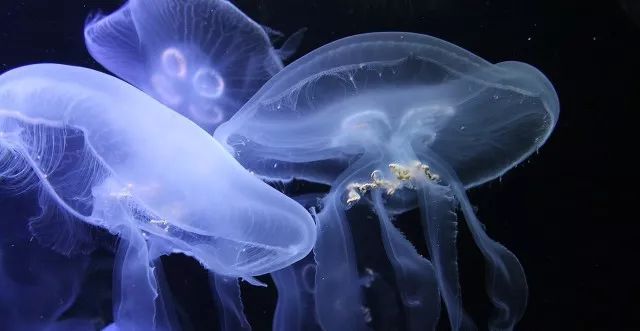
Genuine material platform: Tuwa Creative
Jellyfish has the most primitive and simplest mesh nervous system in multi -cell animals. Its neurons are only connected to each other to form a loose network, there is no center and obvious functional partition, which belongs to a typical "brainless" animal.
Therefore, as long as you know whether the jellyfish will sleep, you can know "whether the brain is necessary for sleep."
How to prove whether jellyfish will sleep?
Jellyfish does not have eyes, can't speak, and can't make lying movements. How can we judge whether they are sleeping? Fortunately, there are three standards for sleep behavior. At present, they are generally accepted in many species and can be used to learn from:
① QuieScence, that is, decreased activity.
② Reduce responSiveNESS (Reduced ResponsiveNESS).
③ Homeostatic Rebound, that is, there will be a rebound after sleep deprivation.
These three standard translation adult words are:
① Sleep less movement.
② The response when I fell asleep was slower.
③ After staying up late or not, you will be sleepy and you must make up for it.
If you use mice, fruit flies and other common models to experiment, it is easy to find materials, but few people invite the marine elves like jellyfish to the laboratory. Therefore, if you want to do this study, it seems that you must go to the sea to catch jellyfish first, otherwise you can only sigh "looking at the ocean".
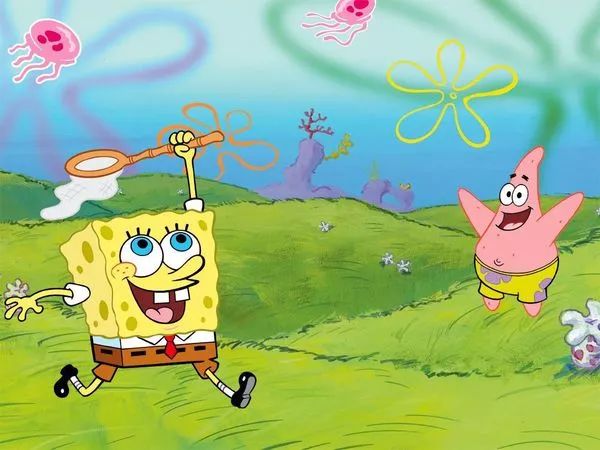
Capture jellyfish. Picture source: "SpongeBob"
Three doctoral students from the California Institute of Technology talked about this problem in a chat after a tea. Coincidentally, one of them just raised a few boxes of jellyfish in other studies.
So the three rushed to the laboratory to find out -when they turned off the lights of the water tank, the magical things happened, and the regular contraction of these jellyfish seemed to slow down, "as if he was sleeping." Therefore, they decided to test it with the strict standards described above. This is not a real sleep.
Test 1
Differences in day and night activity
This jellyfish scientific name is CassiPeais, a jellyfish trained in the laboratory. Unlike jellyfish flying around the aquarium, fairy jellyfish are "inverted" to sit on the bottom of the sea most of the time, which makes them very easy to raise and observe. Usually, they shrink regularly.
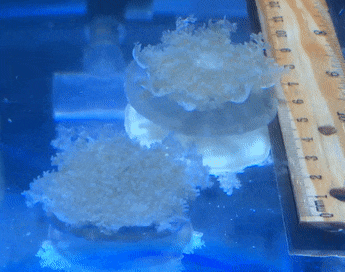
Meng Mengda "Little Fairy". Picture source: reference [4]
They used cameras to record the shrinking behavior of jellyfish during the day and night. It was discovered that these jellyfish shrink regularly every one or two seconds during the day. In the evening, they not only stopped from time to time and stopped shrinking from time to time, but also reduced the frequency during contraction.

Picture source: reference [4]
It is important that this result does not only appear in individual jellyfish. Among the 23 jellyfish they observed, the phenomenon of obviously more active during the day has appeared. During the day, they contracted 58 times per minute, and they contracted 39 times per minute in the evening.
Test 2
Effect on external stimulus reactions
Another feature during sleep is the reduction of stimuli reactions to the external world. To test whether the jellyfish also has this characteristics at night, the three doctoral students also opened their brains and "tailored" a exclusive test method based on the fairy jellyfish's habits.
Fairy jellyfish also naturally likes "houses" -regardless of day or night, as long as there are sudden external forces to drag them from the comfortable "bed" (bottom of the sea), they will swim back quickly. Therefore, the method of testing the reaction speed is to check how fast the fairy jellyfish floats up, and then the response will be fast when you swim back.
They put a fairy jellyfish in a small tube and put them in the water tank together. Every time they measure, they slowly lift the small tube and then let go of them instantly. At this time, the jellyfish floats in the air because of inertia. Subsequently, they will record the time when the jellyfish returns to the bottom of the small tube.

Picture source: reference [4]
The experimental results show that the jellyfish who "sleepy" at night really needed more time to realize that he was not in place, and it took a longer time to return to the bottom. In other words, jellyfish's response to external stimuli at night really slows down.
Test 3
The influence of "stay up late"
To verify the impact of "staying up late" on jellyfish, the first difficulty to encounter is how to make jellyfish "insomnia"? After all, the fairy jellyfish will neither stay up late to swipe their mobile phones nor rush to Deadline. Is there any reason to "insomnia"?
However, from the perspective of the doctoral students of the three thoughts such as the bing, this is not difficult. They quickly found a method: "Keep them tossing them" -iculsive little jellyfish every 20 minutes to blow up the poor little jellyfish and last for 10 seconds to make them sleep unstable all night. Participate in the "Poor) Fairy Jewelry (5x real speed). Picture source: reference [4]
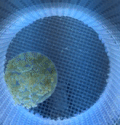
So they used this method to "toss" the fairy jellyfish all night, and then recorded their next activity. Unsurprisingly, the next day, "staying up late", jellyfish's activity really decreased significantly compared to usual; even the next night, they slept more "sinking" than usual.
As a comparison experiment, if the jellyfish was "tossing" during the day, their activity would not have changed greatly with the next night and during the day. It seems that the sleeping mechanism of the fairy jellyfish does have a steady -state adjustment mechanism.
More evidence
Through these three groups of experiments, the three have actually proved that the existence of jellyfish is very close to that we are often called "sleep". However, they want to take a look at whether this behavior is similar to the sleep behavior of other animals in the chemical regulation mechanism.
As a result, they tried to add the molecules commonly regulated sleep and light cycles in the water tank: melatonin. This molecule also has a wider well -known common name- "Brain Platinum". For mammals that are activated during most day activities, the melatonin concentration in serum will decrease during the day and rise at night, thereby regulating the sleeping activity of the whole body [2].
After adding melatonin, jellyfish's movement quickly decreased. Picture source: reference [4]

It is magical that melatonin does reduce the activeness of the fairy jellyfish during the day, and the degree of reduction is also proportional to the concentration of melatonin. In other words, melatonin, a molecule that participates in mammalian sleep regulation, may have amazing evolution conservativeness!
It turned out that "brain platinum" was not a patent of brain animals. As early as the "brain" did not appear, melatonin was already regulating the sleeping behavior of the nervous system!
The above series of research results means that sleep is a characteristic of an animal nervous system that does not depend on the brain and can directly rely on the entire neural network itself. This brings new ideas for scientists to understand "what we want to sleep".
Genuine material platform: Tuwa Creative

This research also provides important clues for the origin of sleep evolution and original function. These may provide some help for scientists to solve the ultimate topic of "the mystery of animal sleep".
postscript:
The "extra -curricular interest group" of three doctoral students
The story behind this study is also unusual. The three doctoral students participating in the experiment, Ravi, Claire and Michael from different laboratories, different majors, and their own "serious" research topics:
From left to right is RAVI, Claire and Michael (photography: John A de Modena). RAVI usually studies the molecular mechanism of thread bug sleep behavior. The main business of Claire is to develop tools for neuroscience through protein engineering means, while Michael's main business is the self -repair of the graduate organization [3].
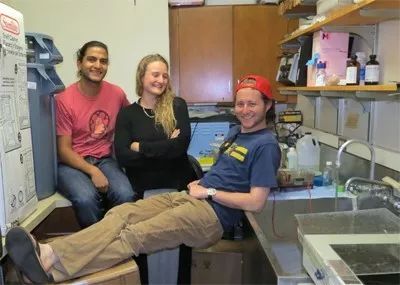
After the three of them discussed the small topic of the jellyfish sleeping, the three reported to their mentors the research plan for "unreasonable business". Unexpectedly, the mentors were very interested in this topic, supported them to purchase test equipment, and allowed them to set up a small laboratory in a idle room in the Sternberg Laboratory in the famous Rodorg Tower [2].
In order to study jellyfish's atypical model creatures, from scratch, they stepped up a set of methods to record jellyfish behaviors and analysis step by step, and finally proved the jellyfish behavior with rigorous scientific methods. The results of this extra -curricular research were finally published in the well -known academic journal "Contemporary Biology" [3].
The neural network simulated by the mosquito as a model allows the robot to automatically avoid obstacles without training. Image source: iFANR

Who knows that those artificial neural networks that look tireless today will also learn to sleep one day in the future?
*Thanks to the two students, Teacher Xiaoqi, Chen Xinhong and Shi Yuelin, and Shi Yuelin for their help to the amendments in this article.
[1] Silverthorn, D. U. (2007). Humanphysiology: An Integrated Approach. San Francisco: Pearson/Benjamincummings.
[2] Melatonin is also often used as a supplement to assist people who have poor sleep or are in the past. However, it is very difficult to effectively administration due to melancholy degradation and other reasons. At present, melatonin is mainly for reviewing "health products" instead of "drugs" in the market. Although it is very successful in business, whether these melatonin products can really improve sleep is not yet concluded in the academic world, and there are still controversial topics.
[3] Conflict of Interest: The author of this article is indirectly benefited from this topic, and has used the luxury desktop machine purchased by this topic for image processing tasks.Claire is the author of the author in this article in the Mentor when rotating in Arnold/Gradinaru Lab, which has greatly helped the author of this article.[4] Nath, R. D., Bedbrook, C. N., Abrams, M. J., Basinger, T., Bois, J. S., Prober, D. A., ... Goentoro, L. (2017). The jellyfish casious asssleep-allGe., 27 (19), 2984-2990. ** This paper is the source of the main content of this article.
[5] Artist: Bruno Murai
Does not represent the position of the Institute of Physics of the Chinese Academy of Sciences
Source: I am a scientist iScientist
Edit: Garrett

- END -
The city in the city is happy to lead senior professional farmers certificate

Putting down the hoe and picked up the pen to further obtained the qualification c...
Deep · Look | Suzhou Science and Technology Innovation Legion "Test Field" in the rice flower fragrance

On July 22, the science and technology board ushered in the third anniversary of t...